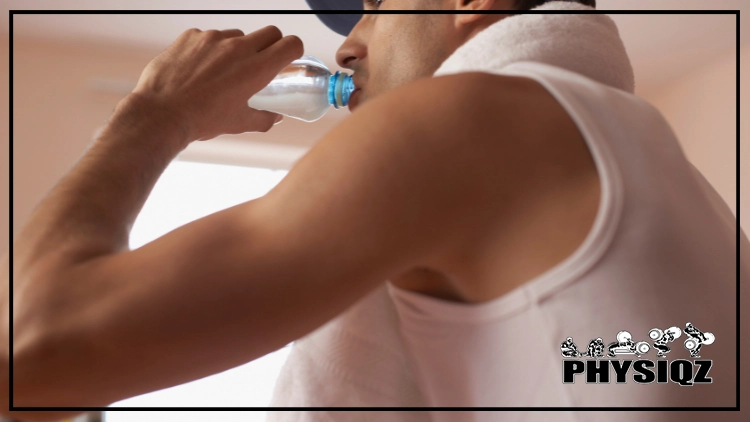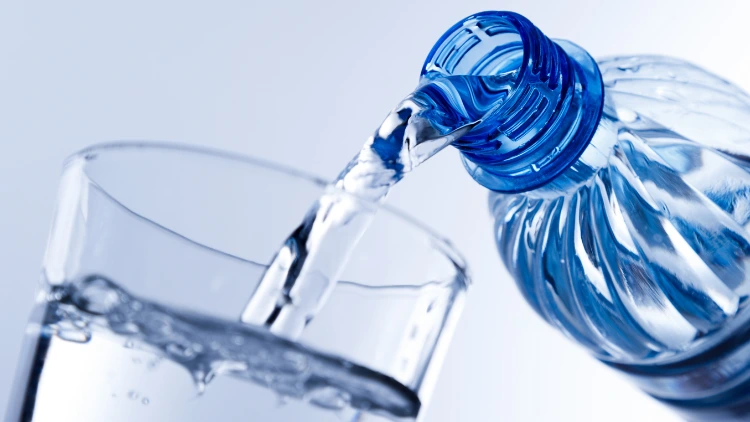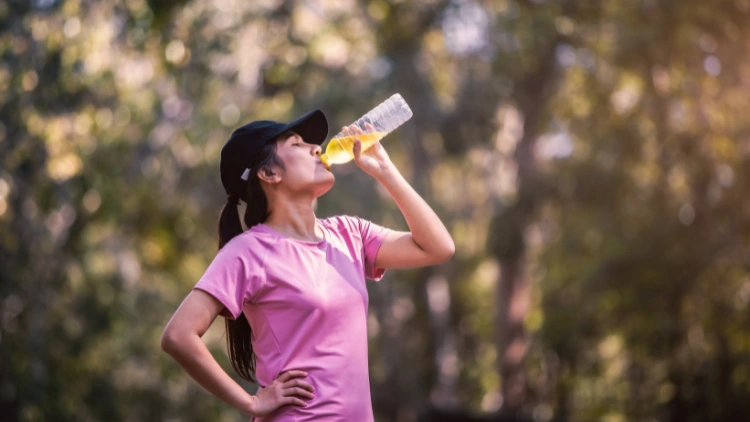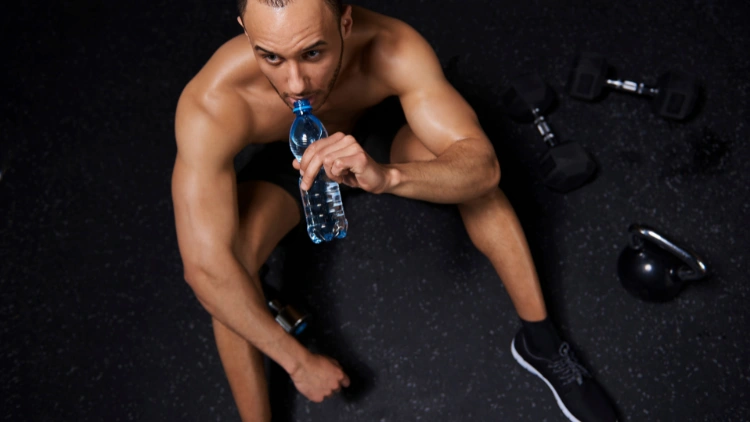
Drinking Propel can be both beneficial and concerning.1 While it provides electrolytes and can be a healthy choice for daily hydration, water remains the best option. Additionally, the artificial sweeteners in Propel raise concerns for some people.
However, by looking at Propels’ ingredients and nutritional value we can paint a picture of its health benefits and downsides that will allow anyone decide on the frequency in which they’re comfortable drinking propel, and if they should use Propel as a water substitute.
So before you consider only drinking propel, consider the ingredients and nutritional value so you can decide for yourself.
An Overview of the Ingredients in Propel
Propel is popular fitness water with several ingredients that help people hydrate while replenishing the essential electrolytes they lose via sweating.2 The tasty drink is not just plain water. Instead, it contains a bunch of other ingredients that enhance the taste and make it more palatable.
And the ingredients in Propel fall somewhere between good and bad. While some Propel ingredients are 100% safe and beneficial to the body, others can be potentially harmful.

Source: FMNG via Canva.com3
The company claims its product is a healthy alternative for those who want to stay hydrated without consuming high sugar levels. However, it is wise to check the ingredients of Propel to determine if it is a suitable substitute for water.
Propel offers three product lines:
- Propel Electrolyte Water
- Propel Immune Support
- Propel Powder Packs.
Though the products differ somehow, most of the Propel ingredients are the same across the product lines.4 Below is an overview of Propel ingredients. However, more Propel nutrition facts will be discussed later to help understand if the drink is healthy.
Water: Water is the main ingredient in Propel, which makes the drink ideal for hydrating the body. It is an excellent option for individuals who want something tastier to break the boredom of drinking plain water.
Salt: The Propel formula has salt that helps the body get enough sodium. Sodium is an essential electrolyte that helps regulate the body’s fluid balance. Salt is also an essential preservative as it prevents the growth of microbes in the beverage.
Artificial Sweeteners: Propel water is considered a keto (low-carb) drink because it is sweetened with artificial sweeteners – sucralose and acesulfame potassium. The nonnutritive sweeteners contain zero sugar and calories. Plus, they are FDA-approved as safe for human consumption.5
Electrolytes: Propel is a sports drink containing electrolytes that the body needs to function correctly. The electrolytes replace those the body loses in sweat, including sodium, potassium, calcium, and magnesium. In fact, Propel has more sodium than tap water.
Vitamins: Propel water contains several fortified vitamins, making it more than just a hydration drink.
- Ascorbic Acid (Vitamin C) – this vitamin is an antioxidant that protects the body from free radicals.
- B-Vitamins – these vitamins are essential for the body to function optimally. They help enzymes break down carbohydrates and fats to produce the energy the body needs, among other functions. They include Vitamin B5, Vitamin B3, Vitamin B12, and Vitamin B6.
- Vitamin E Acetate – an antioxidant that keeps the body safe from harmful radicals.
Zinc – helps repair damaged body tissues and promotes a healthy immune system.
Maltodextrin – it’s a sweetener in the Propel Powder Packets. It also helps in the preservation of the water enhancer.
Preservatives: Like most drinks, Propel products contain several preservatives that help maintain the drink’s flavor and prolong its shelf life. These preservatives include potassium sorbate, citric acid, potassium citrate, sodium benzoate, and calcium disodium EDTA.
Natural Flavor: Extracts from natural substances that create the taste and smell of the beverage.
Note: Propel doesn’t contain artificial dyes or colorings. It is also suitable for individuals following a gluten-free diet.
Propel Nutrition Information Explained
Propel is delicious flavored water packed with essential nutrients, including electrolytes, vitamins, and minerals. It has a clean taste and comes in various flavors, so you can switch things up without worrying about getting bored or missing out on your daily dose of nutrients.
It’s important to consider whether drinking Propel is a good alternative to water. To make an informed decision, it’s essential to examine the facts. Reviewing Propel’s nutritional content can provide clarity on this matter.
Below is Propel nutrition information together with recommended dietary allowance.4
Propel Electrolyte Water Nutrition Facts:
- Calories – 0 (Serving Size 12 fl oz, i.e., 360ml)
The recommended daily allowance is between 1800 and 2000 calories.
- Fat – 0g
The RDA of fat is up to 70-80% of daily calories.
- Protein – 0g
Protein has an RDA of 0.8 grams of protein per kilogram of body weight.
- Total Carbohydrates – 0g
The keto-approved RDA of total carbs and sugar is upto 50g. Thus, Propel is keto-approved.
- Total sugar – 0g
Propel contains a natural flavor and is sweetened with artificial sweeteners containing zero carbs. The drink doesn’t have added sugar.
- Sodium – 160mg
This electrolyte has a 7% Daily Value (DV) in a 2000-calorie diet.
Sodium has an RDA of between 1,500 and 2,300mg
- Potassium – 40mg; 0% DV
The RDA of potassium is 4700mg.
- Vitamin C – 18mg; 20% DV
Ascorbic Acid (Vitamin C) has RDA of 90mg.
- Vitamin E – 1.8mg;10% DV
The RDA of vitamin E is 15mg.
- Niacin (Vitamin B3) – 7.2mg; 45% DV
Niacin has RDA of 16mg.
- Vitamin B6 – 0.7mg; 40% DV
Vitamin B6 has RDA of 1.7mg.
- Pantothenic Acid (Vitamin B5) – 3.6mg; 70% DV
Vitamin B5 has RDA of 5mg.
Propel Immune Support Nutrition Facts:
- Calories – 0 (Serving Size 12 fl oz i.e. 360ml)
- Fat – 0g
- Protein – 0g
- Total Carbohydrates – 0g
- Total sugar – 0g
- Sodium – 160mg
The sodium in Propel Immune Support has a 7% Daily Value (DV) in a 2000-calorie diet.
- Potassium – 40mg; 0% DV
- Vitamin C – 65mg; 70% DV
Propel Immune Support claims to contain 100% of the recommended daily value of vitamin C.
- Vitamin E – 1.8mg; 10% DV
- Niacin – 6.4mg; 40% DV
- Vitamin B6 – 0.7mg; 40% dv
- Pantothenic Acid – 3.6mg; 70% DV
- Zinc – 2.3mg; 20% DV
Propel Powder Pack Nutrition Facts
(Serving Size 1 Packet (2.4g)
- Total Fat 0g
- Total Carbohydrates 0g
- Protein 0g
- Total Sugars 0g
- Sodium – 210mg; 9% DV
- Potassium – 70mg 0%; DV
- Vitamin C – 24mg; 25% DV
- Vitamin E – 5.4mg; 35% DV
- Niacin – 6.4mg; 60% DV
- Vitamin B6 –1mg; 60% DV
- Vitamin B12 – 0.5mcg; 20%
- Pantothenic Acid – 3.6mg; 100% DV
Is Propel Good for You or Bad for You?
Propel is a great source of hydration that can help keep you energized throughout the day. It’s also packed with vitamins, which is why it’s often marketed as a “healthier” alternative to water. While Propel offers certain benefits, it also raises some health concerns. Understanding both the advantages and risks of Propel can help someone on a keto diet make informed decisions about their nutrition.
The Health Benefits of Propel
Below are the health benefits of Propel:

Source: Snowdrop’s Images via Canva.com6
Helps With Hydration: The main ingredient in Propel is water, which is incredibly refreshing and hydrating. It is a great option for individuals who want something sweet for hydration while avoiding carbs and calories.
Low in Calories: Propel water has zero calories and is ideal for people following weight loss rules. An individual can focus on eating healthy foods and getting their exercise in without worrying about their beverage’s calorie count.
Zero Carbs: Propel is a keto-friendly drink because it contains zero carbs and zero sugars. It is sweetened with zero-calorie and sugar-free artificial sweeteners – sucralose and acesulfame potassium. Thus, it is a great way for individuals on keto nutrition to enjoy a sweet drink without worrying about extra carbs or blood sugar.
Replenishes Electrolytes: Propel water is rich in essential electrolytes to help the body replace those lost via sweating. It has 160mg of sodium and 40mg of potassium per 12-oz serving, significantly higher than those in regular water. It’s perfect for people following workout plans since they sweat profusely and require electrolyte replenishment.
Great Source of Vitamins and Minerals: Other than the essential electrolytes, Propel Immune water also contains zinc, an essential mineral for boosting the immune system and repairing damaged tissue.7 Also, Propel water is enriched with valuable vitamins, including Vitamin B and B-Vitamins.
The Health Risks of Propel
Below are the drawbacks of drinking Propel:
Sucralose
The artificial sweetener sucralose is sugar-free and FDA-approved, but it still has some controversies. Some studies assert that it can alter gut flora if used for a long time.8 Other studies suggest that it might also affect glycemic responses in some people and might knock some individuals out of ketosis.9
For these reasons, some people avoid sucralose altogether. And though there is not sufficient evidence to validate these sucralose health concerns, it’s best to consume Propel in moderation when following a ketogenic diet.
Acesulfame Potassium (Ace-K)
Propel also contains Ace-k, an artificial sweetening agent used in many foods and beverages to make them taste sweeter without adding sugar. And while it’s a keto-friendly food additive, there are health concerns about it.
For example, one study has shown that acesulfame potassium affects the gut microbiome and increases body weight in CD-1 mice.10 Thus, it could be a risk factor for obesity and chronic inflammation.
But more studies are needed on humans to authenticate these claims. Also, there were some studies raising concerns that Ace-k might be carcinogenic. But the FDA countered these claims and concluded that it’s safe for human consumption.11
Sodium Hexametaphosphate
Sodium hexametaphosphate is an additive that preserves Propel’s flavor. It’s FDA-approved for standard use (1% concentration). However, studies indicate that the additive can have adverse health impacts, such as skin and gastrointestinal irritation, kidney damage, and parathyroid issues, if taken in high concentrations (above 10%).12
And though it might have minimal toxicity in Propel, an individual might want to limit the drink’s consumption to avoid possible health hazards.
Maltodextrin
Propel Powder Packets contain maltodextrin, an additive that contains maltose to help fitness enthusiasts gain quick energy. However, maltodextrin has a high glycaemic index and can raise blood sugar levels, rendering Propel power packets unfit for keto.13
Plus, maltodextrin can trigger insulin resistance in the body, making it bad for people with diabetes. Individuals on weight loss diets should also avoid maltodextrin since it promotes weight gain.
Sodium
Propel water is rich in sodium (160mg per 12 oz serving size). The body needs a small amount of sodium for proper functioning and maintaining electrolyte balance. Too much of it can be hazardous.
The RDA of sodium is 1500-2300mg, and exceeding this limit can lead to high blood pressure – a risk factor for heart disease.14 Thus, individuals limiting sodium intake might consume Propel in moderation. Also, those with high blood pressure should avoid Propel altogether.
Propel vs Regular Water: Which Is Better?
Whether Propel or regular water is better than the other, it depends.
For fitness enthusiasts who exercise vigorously, Propel is an ideal source of hydration. It has more essential electrolytes (sodium and potassium) than regular water, so it helps replace the electrolytes lost in sweating.
However, individuals on workout plans should take Propel during workout sessions only. This is because prolonged intake of Propel might lead to a high concentration of sodium in the blood (hypernatremia). The signs of hypernatremia include irritability, unconsciousness, and muscle weakness.
Propel water is also a better option for people taking trending diets such as keto and wanting something tasty to replace boring water. Plain water is sometimes boring, and while it’s essential, people just want something a little more exciting to quench their thirst.
That said, Propel is a perfect alternative for people in need of a quick pick-me-up and who don’t want to drink plain water all day long – but in moderation. The best part is that Propel water is keto-friendly (but Propel powder packets are not).
Again, Propel contains sweeteners and additives such as Sucralose, acesulfame potassium, maltodextrin, and sodium hexametaphosphate – which could have health risks if taken in excess amounts.15 To avoid such, it is better to drink regular water.
And for people following light workout plans and those who don’t exercise at all, Propel water is not necessary. They don’t sweat profusely (or at all), so they aren’t at risk of electrolyte imbalance.
In fact, the electrolytes in their diet (e.g., spinach, kale, and avocados) are sufficient enough to replenish those lost via mild sweat or no sweat at all. For such people, water is better than Propel for hydrating the body.
Is It Okay if I Drink Propel Instead of Water? The Final Verdict
The answer to whether it’s okay to drink Propel instead of water can be confusing, but it’s the truth. It really depends on the individual’s specific needs. There’s no doubt that Propel is an effective rehydration drink because it’s got the electrolytes and vitamins the body needs to get hydrated.
So, if an individual is exercising or working out regularly and need electrolyte replenishment during workout sessions, it is okay to drink Propel instead of plain water.

Source: Gpoint Studio via Canva.com16
In fact, strenuous exercises and drinking regular water can cause salt depletion in the body, causing a condition called salt depletion heat exhaustion. Salt depletion heat exhaustion is a mild syndrome where there is a depletion of sodium and water in the body.17 Thus, drinking Propel instead of water is okay to avoid such a health crisis.
Or, if someone wants to replace one glass of water per day with Propel, that can be healthy too as long as they don’t wind up solely drinking Propel since it’s more flavorful.
And even though Propel comes with beneficial electrolytes and vitamins, it has artificial sweeteners and ingredients that be harmful with prolonged use.
So, generally speaking, water is the best healthy drink to help with hydration in day-to-day life. It doesn’t contain controversial additives that could potentially pose health risks. As such, it is not recommendable to use electrolyte drinks like Propel as substitutes for regular water.
If an individual is just thirsty at work or home and not sweating profusely, Propel will not help them hydrate any faster than simply drinking plain water. The electrolytes one gets from their diet are sufficient to maintain electrolyte balance in normal life.
Ultimately, Propel is a tasty electrolyte water that can help workout enthusiasts stay hydrated. Though it contains essential vitamins and electrolytes, it has unnatural ingredients that could be potentially harmful.
On the other hand, water is a healthy, natural source of hydration that’s completely safe to drink daily. As for Propel, it can be an alternative in some cases, but it depends on the situation.
Frequently Asked Questions
When Is It Okay To Drink Propel Instead of Water?
It is okay to drink Propel instead when doing rigorous exercises to replace the water and electrolytes lost through sweating. In addition, it is okay to drink propel instead of water in moderation or for in place of one glass of water a day.
Is Propel Keto Approved?
Propel water is keto approved because it is sugar-free and contains zero carbs. However, Propel power packets are not keto approved since they have maltodextrin, which has a high glycemic index.
Does Propel Break a Fast?
Propel doesn’t break a fast when fasting to lose weight. But if an individual is fasting for autophagy, Propel can break a fast since it contains artificial sweeteners.
Can Propel Water Help With Weight Loss?
Like regular water, Propel has zero calories and can’t cause weight gain. But just drinking Propel can’t help an individual lose weight since they need to watch over their diet and track calorie intake.
Does Propel Water Help You Hydrate? How?
Yes, Propel helps with hydration. It is sports water high in electrolytes and can help replenish the electrolytes lost via sweat.
How Much Electrolytes Are in Propel?
One serving of Propel electrolyte water (360ml) contains 160mg of Sodium and 40mg of potassium.
References
1Jupiterimages. Canva, 13 December 2011. Accessed 13 April 2023. <https://www.canva.com/photos/MAC7_bSIGPU-man-drinking-water/>
2MedlinePlus: Electrolytes. <https://medlineplus.gov/ency/article/002350.htm>
3FMNG. Canva. Accessed 13 April 2023. <https://www.canva.com/photos/MAC8ta3HMJQ-drinking-water/>
4Propel Products. <https://www.propelwater.com/products>
5Nichol, A. D., Holle, M. J., & An, R. (2018). Glycemic impact of non-nutritive sweeteners: a systematic review and meta-analysis of randomized controlled trials. European journal of clinical nutrition, 72(6), 796-804. <https://pubmed.ncbi.nlm.nih.gov/29760482/>
6Snowdrop’s Images. Canva, 20 April 2019. Accessed 13 April 2023. <https://www.canva.com/photos/MAFX-k_Mt28-woman-sport-athletes-drinking-water-with-electrolytes-after-exer/>
7Roohani, N., Hurrell, R., Kelishadi, R., & Schulin, R. (2013). Zinc and its importance for human health: An integrative review. Journal of research in medical sciences: the official journal of Isfahan University of Medical Sciences, 18(2), 144. <https://www.ncbi.nlm.nih.gov/pmc/articles/PMC3724376/>
8Schiffman, S. S., & Rother, K. I. (2013). Sucralose, a synthetic organochlorine sweetener: overview of biological issues. Journal of Toxicology and Environmental Health, Part B, 16(7), 399-451 <https://www.ncbi.nlm.nih.gov/pmc/articles/PMC3856475/>
9Pepino, M. Y., Tiemann, C. D., Patterson, B. W., Wice, B. M., & Klein, S. (2013). Sucralose affects glycemic and hormonal responses to an oral glucose load. Diabetes care, 36(9), 2530-2535 <https://pubmed.ncbi.nlm.nih.gov/23633524/>
10Bian, X., Chi, L., Gao, B., Tu, P., Ru, H., & Lu, K. (2017). The artificial sweetener acesulfame potassium affects the gut microbiome and body weight gain in CD-1 mice. PloS one, 12(6), e0178426 <https://pubmed.ncbi.nlm.nih.gov/28594855/>
11FDA. (1988). Food Additives Permitted For Direct Addition To Food For Human Consumption; Acesulfame Potassium. <https://www.fda.gov/media/89181/download>
12Lanigan, R. S. (2001). Final report on the safety assessment of Sodium Metaphosphate, Sodium Trimetaphosphate, and Sodium Hexametaphosphate. International journal of toxicology, 20, 75-89. <https://pubmed.ncbi.nlm.nih.gov/11766135/>
13Hofman, D. L., Van Buul, V. J., & Brouns, F. J. (2016). Nutrition, health, and regulatory aspects of digestible maltodextrins. Critical reviews in food science and nutrition, 56(12), 2091-2100. <https://www.ncbi.nlm.nih.gov/pmc/articles/PMC4940893/>
14Grillo, A., Salvi, L., Coruzzi, P., Salvi, P., & Parati, G. (2019). Sodium intake and hypertension. Nutrients, 11(9), 1970. <https://www.ncbi.nlm.nih.gov/pmc/articles/PMC6770596/>
15Tandel, K. R. (2011). Sugar substitutes: Health controversy over perceived benefits. Journal of Pharmacology and Pharmacotherapeutics, 2(4), 236-243. <https://www.ncbi.nlm.nih.gov/pmc/articles/PMC3198517/>
16Gpoint Studio. Canva, 13 December 2011. Accessed 13 April 2023. <https://www.canva.com/photos/MACTrWWCGms-man-drinking-water/>
17Leithead, C. S., Leithead, L. A., & Lee, F. D. (1958). Salt-deficiency heat exhaustion. Annals of Tropical Medicine & Parasitology, 52(4), 456-467. <https://pubmed.ncbi.nlm.nih.gov/13617929/>